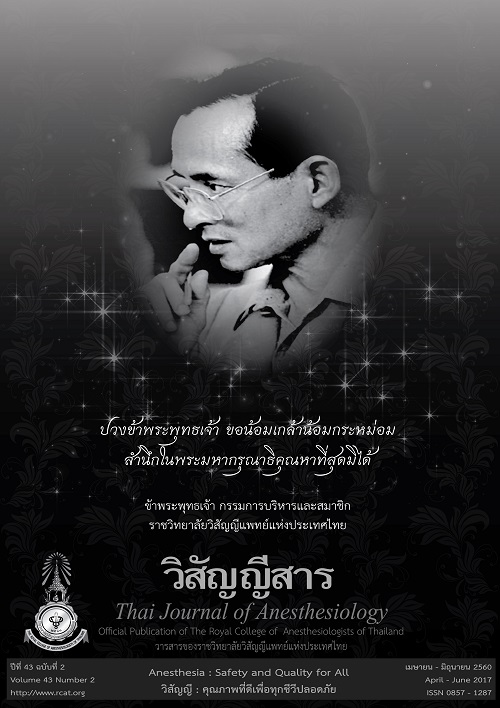The appropriate propofol effect-site concentrationby Schnider model in neurosurgery adjusted by bispectral index
Main Article Content
Abstract
Objective: To determine the appropriate propofol
effect-site concentration (Ce) in patient undergoing
neurosurgery. Methods: The prospective descriptive
study was performed by the randomization among
neurosurgical patients who received general
anesthesia. The target controlled infusion of propofol
with 4 μg/ml of effect-site target concentration (Cet)
setting was selected as an induction. The Cet was
adjusted 0.2 μg/ml periodically every 30 seconds to
control bispectral index (BIS) in the range of 40-60
during the operation. The Ce, BIS, blood pressure and
heart rate were recorded at each time from anesthetic
induction through emergence period. The descriptive
statistics were used. The variables correlation were
analyzed with Pearson’s correlation and logistic
regression with the statistical significant at p-value
<0.05. Results: One thousand and forty one values
of Ce from 48 patients were observed. The Ce at loss
of eyelash reflex, before intubation, positioning,
skin incision and the average during anesthetic
maintenance were 5.29±0.71, 4.95±0.64, 3.79±1.06,
3.05±0.56 and 3.10±0.90 μg/ml consequently. The
systolic blood pressures were ranged in 98.63±18.10
to 136.31±15.34 mmHg while the heart rates were
64.19±10.85 to 75.58±14.69 beats/min. Time to
eye opening, extubation and verbal response were
9-12 min after setting Cet at 0 μg/ml. The negative
correlation between Ce and BIS was demonstrated
(R = -0.45, p-value < 0.001). Moreover,
during anesthetic maintenance, the BIS value was
decreased 6.14 (-6.99 to -5.28; p-value < 0.001) for
every 1 μg/ml increased in Ce value. Conclusion: The
propofol effect-site concentration during
neurosurgery should be figured appropriately between
3-5 μg/ml in order to maintain adequate depth of
anesthesia and disturb less cardiovascular system.


